Klaksvík City Center Entry by Group8
By Bustler Editors|
Friday, Jun 15, 2012
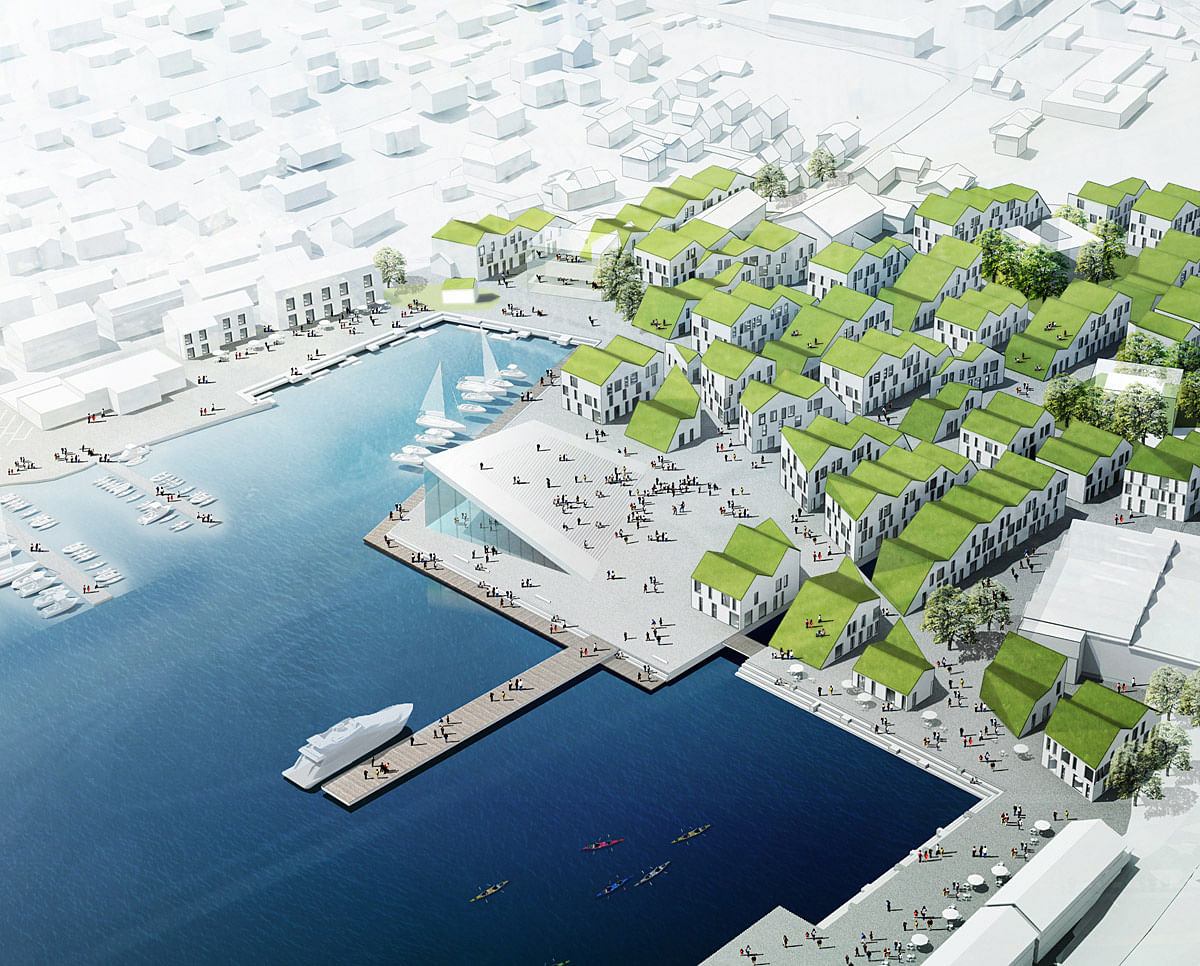
Related
We have received another entry for the city center redevelopment competition in Klaksvík, Faroe Islands: the proposal "RE-CONNECT, RE-INVENT, RE-INVEST KLAKSVIK" by Swiss firm Group8 received the 2nd prize in this open, international competition.
Group8's concept for the new Klaksvík city center was inspired by "a dense and controlled scale of intervention, based on a strong network where each part of the town will be interconnected through sustainable methods of moving, thus providing a green means of living to all inhabitants."
Project Description from the Architects:
“Klaksvik New City Centre” aims to become a model of design that is environmentally, economically and socially sustainable; a place synonymous with modern ideals for living, working, being. The inter-connected city enhances the close relationship between the actors within. With its unique waterfront, green traffic systems and an emphasized accessibility which re-connects the two banks of the town, “Klaksvik New City Centre” sets forth a friendly and environmentally sound place to work and live. It is ready to answer to the new ambitions of the town, while maintaining strong traditions. Composed of a diversity of programmes and large spaces open to the sea, the “New City Centre” is an ambassador for the development of the Faroe Islands.
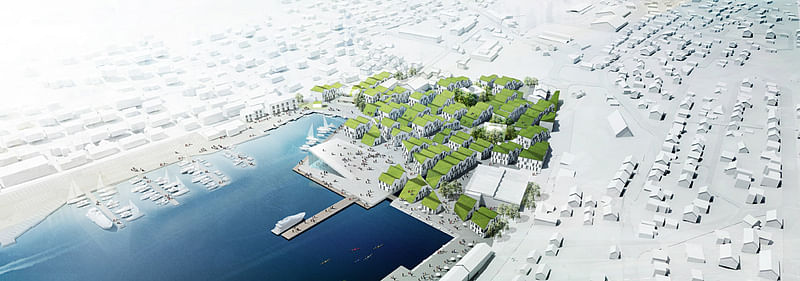
STRATEGY
The main concern therefore is the creation of a community whilst maintaining a working economy. The overall goal of such urban planning should be to create a sustainable community by providing an amenable central town area, improving the connectivity in the city and providing a layout that fosters the community.
Our strategy is to reinforce that which already exists, to intensify, to stimulate and to explore the urban and architectural potential of the unique conditions of the actual town.
How to re-connect the East and West parts of the town?
How to re-invest the central landfill exposed at the sea-facing side?
How to re-invent Klaksvik as a dynamic, unique and sustainable city centre?
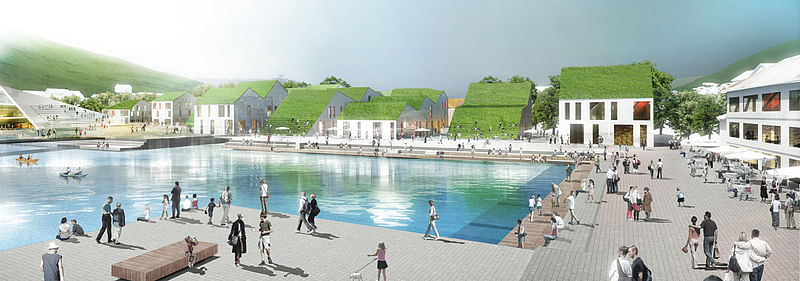
PROCESS
- The New City Centre site is a unique and readily identified area, which will express a new character for the town.
- In order to increase density in this area by enhancing effective connectivity, an “intelligent” grid will follow the existing urban fabric of the banks, creating essential links between the land, the sea, and the east and west parts of the town.
- The layout creates a non-hierarchical street network and increases the accessibility of the town centre with a total porosity between the centre and the rest of the town. As a car free area, the new town centre is dedicated to green mobility.
- The shore, unfriendly and unexplored at the moment, is reshaped and fully integrated as a new promenade. As the essence of the Klaksvik spirit, the proximity to the sea is now emphasized. The waterfront is transformed into a special place, unique for the town, where new activities are created all along. People can reach the front bank by walking along the sea instead of crossing the entire town by car.
- The “connecting grid” is cut and adapted by the pre-existing city connections, such as the church walkway, the gate corner, and the east and west sides of the town. An inner network is created - an “inner belt” - offering a constellational linking of several of the city nodes.
- The New City Centre builds itself within its existing conditions. The heritage buildings are preserved on site: the brewery, the post office, the cultural house, and integrated into the grid layout.
- Within the grid, some blocks are subtracted along the “inner belt” in order to create voids which will define open plazas as vibrantly public spaces. Open spaces – “voids” create meeting places: a large plaza, open to the sea; a park surrounding a public programme; or an intimate plaza around an institutional building.
- A city centre needs landmarks; they provide extraordinary features, orientation and identity. For this reason, every “void” establishes a public programme, easy to recognize and to identify.
- An extraordinary town centre is now created, car-free with a new large “town plaza“, open to the sea. The New City Centre illustrates a neighborhood within itself, where all places within becomes exceptional with its own views, perspectives and ambiences. Every place shall have its own identity, its specificity, its quality. It allows the town centre to be an “intelligent” neighborhood rather than a repetitive grid plan, where every corner looks the same.
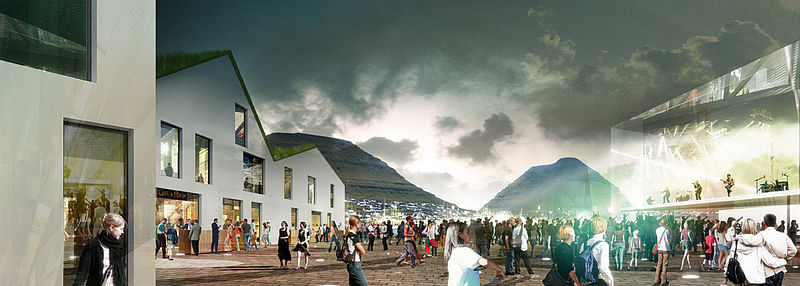
SUSTAINABLE STRATEGY& MOBILITY
The new master plan for the New City Centre allows all inhabitants to be completely involved in the development of the city and become a part of the momentous process. More than any other city, Klaksvik aims to be a model of a perfect work-life balance. “A new, pedestrianised, seaside neighborhood” shall become the new face of Klaksvik. The size of the streets will be developed to allow variable usage, which will encourage attractive and specific programmes. The relationships and connectivity between people of the town will lead to a new concept for the city, where human scale is respected and interconnections between people encouraged. By controlling the density and the programmatic diversity, we offer Klaksvik a particular identity based on sustainable parameters. The large area along the sea offers the whole area a strong maritime character with a quiet and unique shore.
Klaksvik New City Centre concept is a network of street and plaza, with a concentration of activities, social exchange settings, public functions, open spaces, iconic buildings: places to meet, places to work, places to live.
A compact city composed of a diversity of programmes, is friendlier and reduces the need for cars, thus reducing a large amount of energy used for transport. Fewer cars mean fewer traffic jams and better air quality, encouraging people to move instead by walking or by bicycle.
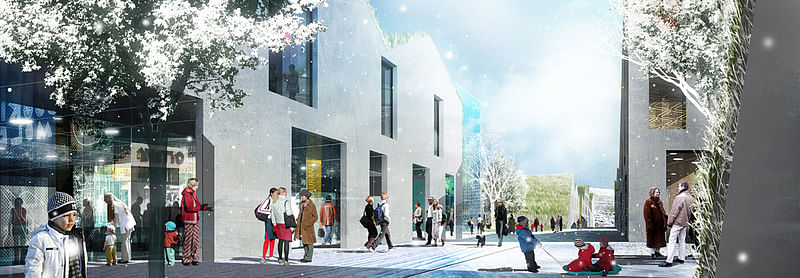
Social & identity
Working with the special climatic conditions of Klaksvik, the New City Centre offers some protected areas (marketplaces, terraces, promenades) but also some protected arcades in order to allow pedestrian flows from one point of the centre to another. A sustainable town is a town which works despite the weather conditions.
Sustainability is also attached to the identification with a city, by urban furniture, signage, landmark buildings, landmark landscapes, hardscape, and places easily appropriated by inhabitants.
Energy
The sustainable city centre offers good thermal comfort inside buildings (insulated with the traditional vegetal green roof). Attached to this roof can be solar heating solar tubes which respond to the needs of the buildings. The gradient of the roof slopes is to be determined, but previous calculation and studies recommend allowing the north side slopes a gradient of xx°to xx° and for the South side a gradient of xx° to xx°. Energy saving small scale buildings is easier to heat than bigger ones, drawing significant advantage.
The grid, which will create all streets and built areas, presents appropriate distances between buildings in terms of light and ventilation. Specific height (one to two storeys up the ground) will optimize views and light penetration into buildings, reducing the need for artificial light. The skyline created by the green roof intervention will give the whole area its particular “landscape identity”, which will be the new urban signature of Klaksvik.
Mobility& accessibility
What makes cities come to life? Economy, human interactions, social networks, citizens, exchange of goods and ideas. Cities must be open and allow the free flow of communication. Spaces, not buildings create cities. Thus the “grid” provides a smart network of streets that link urban spaces into the now. It allows people and information to flow freely, which nurtures business, culture and social interaction. Why is such a network a plus? It will allow easy traffic, movement and mobility.
The streets of the New City Centre of Klaksvik are planned with a width of 8 meters to support the varying intensity of urban activities: pedestrians only, pedestrians + cars, pedestrians + bicycles. The road network is planned in order to minimize the impact of the car and to increase soft mobility.
A large majority of roads shall be pedestrianised, excluding the “constellation network”, where shuttle buses and cars for drop off operate. To encourage people car-free mobility, streets have a unique ground covering making the use of bicycles easier. Some bicycle/ parks are positioned in the centre, with bicycle rentals integrated into the programme.
An electric shuttle bus, serving the whole town, is also to be considered, with stops every 300 meters along the sides of the town, parallel to the shore, in order to “irrigate” all areas of Klaksvik. This shuttle bus will have two stops in the centre - one on the main plaza near the sea, and the other in the public library space, easy reachable from the town hall plaza.
At the entrance to the city centre, a large landscaped parking area occupies the existing green field. Visitors to Klaksvik will leave their cars here and reach the town centre on foot. Other parking lots, some existing, some new, shall be placed at crucial situations, where direct car connections to the centre arrive.
Klaksvik New City Centre concept is a network of street and plaza, with a concentration of activities, social exchange settings, public functions, open spaces, iconic buildings: places to meet, places to work, places to live.
A compact city composed of a diversity of programmes, is friendlier and reduces the need for cars, thus reducing a large amount of energy used for transport. Fewer cars mean fewer traffic jams and better air quality, encouraging people to move instead by walking or by bicycle.
Social & identity
Working with the special climatic conditions of Klaksvik, the New City Centre offers some protected areas (marketplaces, terraces, promenades) but also some protected arcades in order to allow pedestrian flows from one point of the centre to another. A sustainable town is a town which works despite the weather conditions.
Sustainability is also attached to the identification with a city, by urban furniture, signage, landmark buildings, landmark landscapes, hardscape, and places easily appropriated by inhabitants.
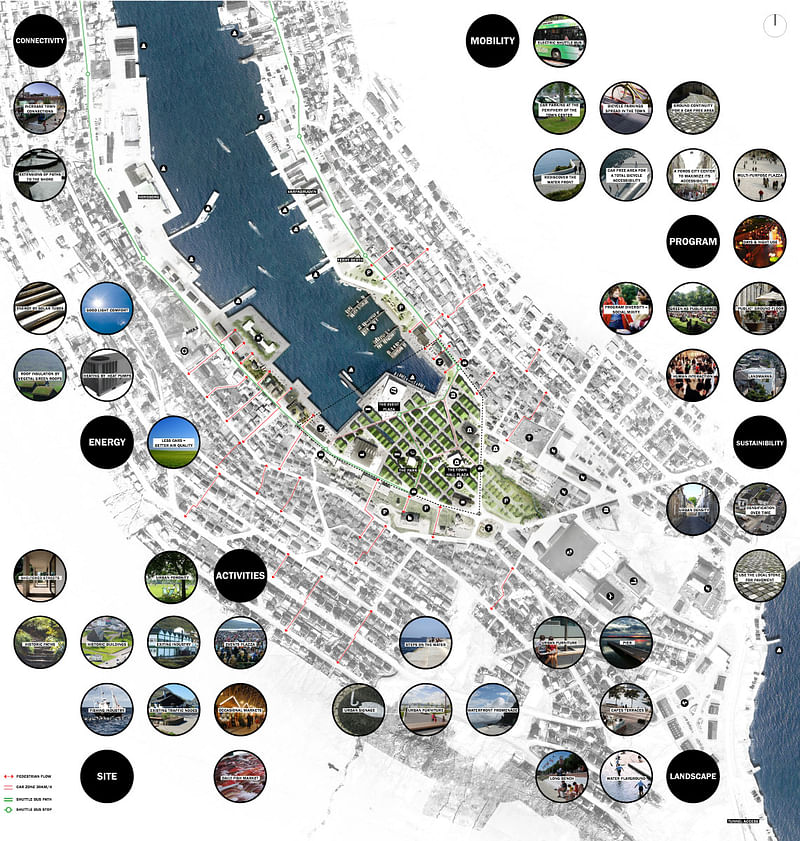
PROGRAM
Social diversityis one solution for a sustainable city centre. And this comes from the programmatic diversity, which brings together an increasing human diversity, creates greater occupation all of the time, and establishes more diversity of human contact (young people, elderly, families, active people...).
The New City Centre of Klaksvik hosts an efficient “public ground floor”, dedicated to public programmes as shops, restaurants, pubs, offices, institutions, public services, kindergarten, hotels, youth hostels and so on….The “ground floor” works during the day but also at night, at weekends and during holidays. In contrast to the usual “shopping malls” or “shopping streets”, the city centre offers dynamism and activity everywhere within its area.
On the higher levels are housing programmes and offices. Apartments occupy the central part while offices are placed at the periphery for acoustic reasons.
The cultural and institutional programmes such as the town hall, the library, the sea museum, the multi-functional hall and the cultural house are located in the main, larger buildings, as the town’s landmarks.
The hub place will be the large square in front of the sea, able to host all large events such as the summer festival, seamen’s day, the northern islands festival, or communal events such as live concerts, demonstrations and other cultural events, as well as a Christmas market, a weekly market, a daily fish market, and playgrounds for kids.
The bus terminal is located at the entrance of the city, close to the post office, easy to reach from every part of the town.
SHORE STRATEGY
The existing shore presents much diversity in the wealth of qualities of the water front: as piers, bays, harbour wharf, or even as potential promenades.
The new water front is inspired by all these special relations to the sea and empathizes with the pre-existing character of the “maritime” face of the town centre.
As the new artery of the city, and linking the east and west banks of the town, the new shore will play host to a plethora of activities such as a water playground, water terraces, boat berths, a bench-bordered promenade, a pier facing out to the horizon, as well as a shore promenade for long walks, jogging etc…The historical paths between the roads are now extended to the shore as “shortcuts” to the sea.
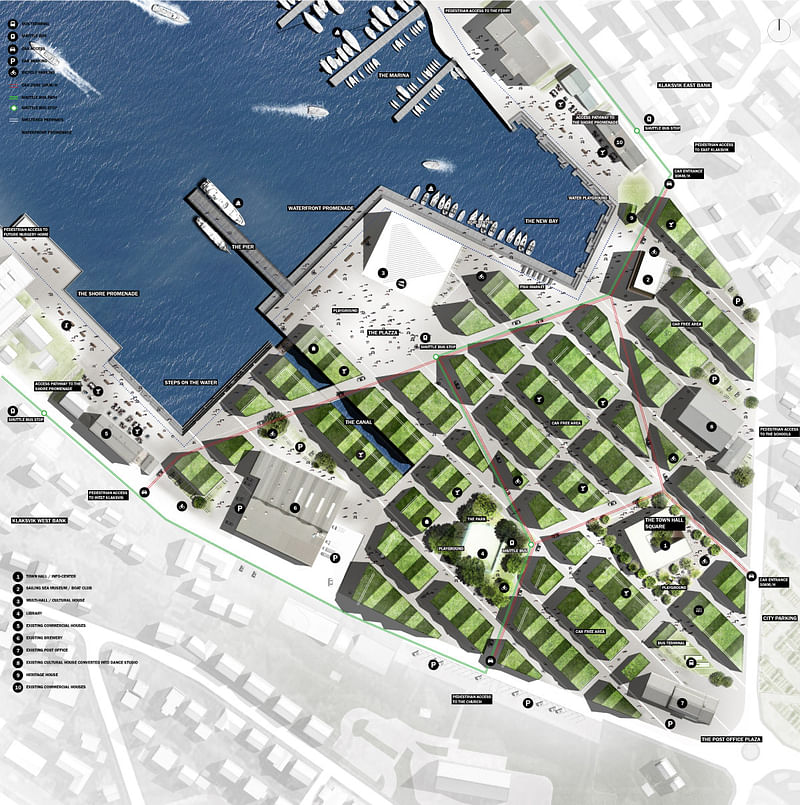
PHASING
The phasing of the construction of the New City Centre of Klaksvik will follow a densification over time, stage after stage, avoiding major construction in one specific period.
The first stage will give the essential premises of the new area, without demolitions, which will redefine the new shore. The front buildings will establish three main streets to make the first links between the town and its new centre. Secondly, the major part of the area shall be built, with some demolition, in order to consolidate the street networks. The bird’s eye view shown in the perspective represents the final step of the evolution, which sees the completion of the system and the destruction of the any remaining buildings that may have been relocated in the new master plan. To conclude, the network grid is placed in such way that it will allow for the development of the area with a strong flexibility that enables construction to start without damage to the existing buildings.
CONCLUSION
The Klaksvik New City Centre is characterized by pedestrian areas and their natural surroundings, like mountains and sea.
With a dense and controlled scale of intervention, based on a strong network, each part of the town will now be interconnected through sustainable methods of moving, thus providing a green means of living to all inhabitants. As a symbol of the new sustainable city, the New City Centre brings huge potential to the city for development and a strong image, easily identifiable and promotable as one of the new centers of the Faroe Islands. The “Klaksvik New City Centre” will allow a high level of standards in terms of sustainability and offer the best surroundings in which to develop an ideal place to work and live in full respect of nature.
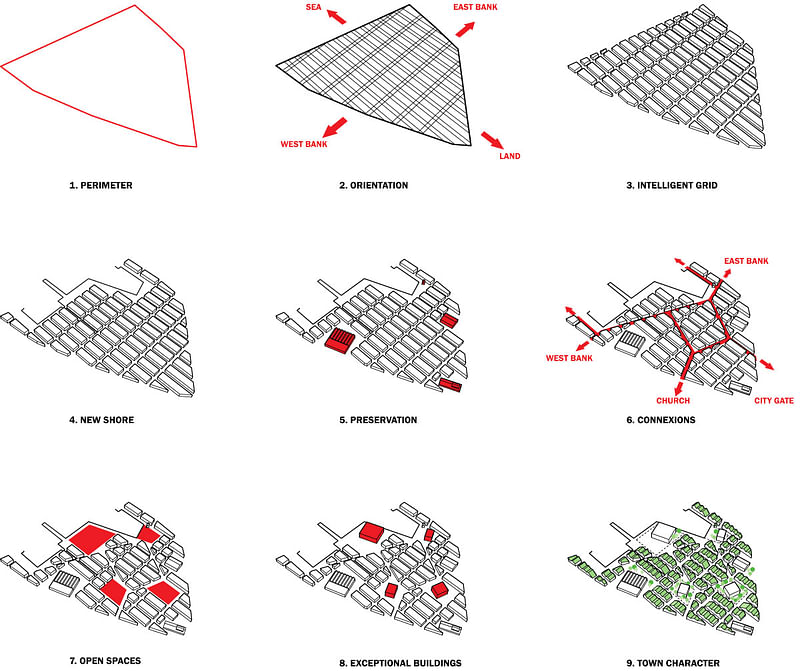
Project Details:
Company: Group8 Architecture & Urban Planning
Location: Klaksvík, Faroe Islands
Client: Municipality of Klaksvík
Site area: 150,000 sqm; Study Area: 7.6 ha
Architects: Laurent Ammeter, Adrien Besson, Tarramo Broennimann, Manuel Der Hagopian, François de Marignac, Grégoire Du Pasquier, Oscar Frisk, Christophe Pidoux
Type: Open International Competition, 2nd prize
Program: apartment, commerce, administration office, tourist information office, hotel, library, sailing sea museum, culture house, bus terminal

Share
0 Comments
Comment as :